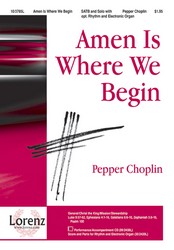- |
User Links
Amen, Amen

See the little baby
Author (verses): Jester Hairston; Author (refrain): B.H. Hogan; Author (refrain): Laura B. DavisTune: AMEN (Spiritual)
Published in 24 hymnals
Printable scores: PDF, MusicXMLAudio files: MIDI
Representative Text
Refrain:
Amen, amen, amen, amen, amen.
Amen, amen, amen, amen, amen.
1 See the baby,
lyin' in the manger
on Christmas mornin'. [Refrain]
2 See Him at the temple,
talkin' to the elders;
how they marveled at his wisdom,
3 See Him at the Jordan
where John was baptizin'
and savin' all sinners. [Refrain]
4 See Him at the seaside,
talkin' to the fishermen
and makin' them disciples. [Refrain]
5 Marchin' in Jerusalem,
over palm branches,
in pomp and splendor. [Refrain]
6 See Him in the garden,
prayin' to His Father,
in deepest sorrow.
7 Led before Pilate,
then they crucified Him,
but He rose on Easter. [Refrain]
8 Hallelujah!
He died to save us
and He lives for ever. [Refrain]
Source: One Lord, One Faith, One Baptism: an African American ecumenical hymnal #294
Author (verses): Jester Hairston
(no biographical information available about Jester Hairston.) Go to person page >Author (refrain): B.H. Hogan
Rev. Broadus Henry Hogan Go to person page >Author (refrain): Laura B. Davis
Laura Belle Davis. Born 20 Oct. 1909 in Indianapolis, daughter of William Scott Davis and Clara Montague. Go to person page >Text Information
| First Line: | See the little baby |
| Title: | Amen, Amen |
| Author (verses): | Jester Hairston |
| Author (refrain): | B.H. Hogan |
| Author (refrain): | Laura B. Davis |
| Meter: | Irregular |
| Language: | English |
| Refrain First Line: | Amen, Amen |
| Notes: | Ostinato refrain |
| Copyright: | Refrain ©1935 Homer A. Rodeheaver, renewed 1963, sold to Word Music in 1969 [expired in 2011]. Melody and Lyrics by Hairston ©1957 Walter Schumann Co., acquired in 1965 by Bourne Music Co., renewed in 1985. |
English
- 50 Sacred Favorites #4
- African American Heritage Hymnal #649
- African Methodist Episcopal Church Hymnal #172
- Bible Songs on Timeless Themes #29
- Hymns for the Living Church #126
- Lift Every Voice and Sing II: an African American hymnal #233
- New Church Praise #84
- One Lord, One Faith, One Baptism: an African American ecumenical hymnal #294
- Psalter Hymnal (Gray) #365
- Sing With Me #88 10 shown out of 18
Korean
Notes
Scripture References:
st. 1 = Luke 2:6-7
st. 2 = Luke 2:46-47
st. 3 = Mark 3:7-12, Mark 6:53-56
st. 4 = Matt. 26:36-46, Mark 14:32-42, Luke 22:39-46
st. 5 = Matt. 27:32-35, Matt. 28:1, Mark 15:21-26, Mark 16:1-7, Luke 23:26-34, Luke 24:1-8, John 19:16-18, John 20:1-2
A traditional African American spiritual, "Amen" arose from oral tradition; thus different hymnals contain variations in the text. Donald Hustad believes "Amen" probably comes from the twentieth century. With a choral arrangement by long-time promoter of spirituals Jester Hairston, this hymn was the theme song for the film Lilies of the Field (1963) starring Sidney Poitier. The text gives glimpses into Jesus' life: his birth (st. 1); his wisdom as a twelve-year-old, which astounded the temple rulers (st. 2); his preaching and healing ministry (st. 3); his suffering in Gethsemane (st. 4); and his crucifixion and victorious resurrection (st. 5). All text is framed by the repeated "Amen" responses; as we sing we reaffirm that “truly, truly, this is the gospel!”
Liturgical Use:
Christmas Day; Epiphany; Lent; Easter; anytime with children; whenever you need a simple attractive synopsis of Christ's life set to essentially two-part music.
--Psalter Hymnal Handbook, 1988
Tune
AMEN (Spiritual)The traditional call-and-response structure calls for a soloist on the text, with everyone singing the ostinato pattern of "Amens," either in unison or harmony. The soloist may apply rhythmic and melodic freedom to the lines. If possible, sing unaccompanied, or use piano, guitars, and/or string bass…


 My Starred Hymns
My Starred Hymns





